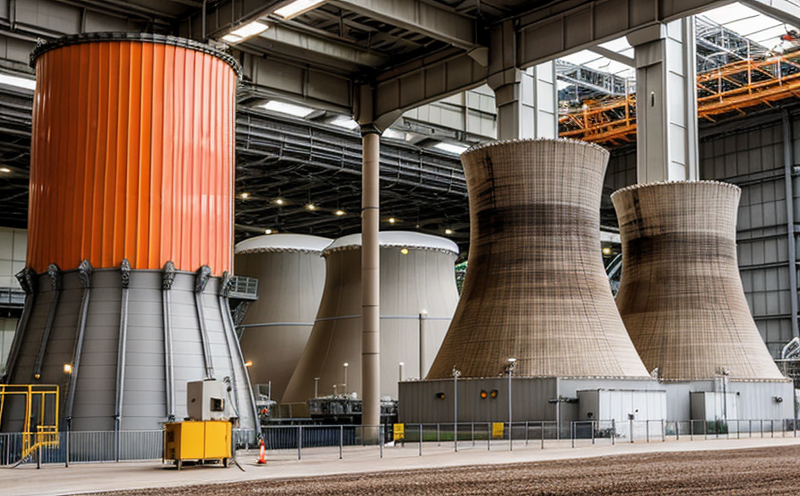ASTM E560 Practices for Conducting Reactor Surveillance Programs
The ASTM E560 standard provides a comprehensive framework for conducting reactor surveillance programs, ensuring the integrity and safety of nuclear power plant materials and components. This practice is crucial in the context of nuclear power generation, as it helps prevent potential failures that could lead to accidents or breaches in containment systems.
ASTM E560 focuses on several key aspects including the selection of appropriate surveillance specimens, the methods for sampling and testing, and the criteria used to evaluate test results. The standard is designed to ensure that materials and components are subjected to rigorous testing under conditions that simulate actual reactor environments as closely as possible.
The practice covers a wide range of tests and evaluations aimed at detecting potential flaws or degradation in critical components such as pressure vessels, steam generators, and other structural elements. The ASTM E560 standard is particularly important for materials like stainless steel, nickel-based alloys, and titanium that are commonly used in nuclear power plants due to their high-temperature strength and resistance to radiation-induced damage.
The testing protocols outlined in ASTM E560 include mechanical property tests such as tensile testing, hardness measurements, and fracture toughness evaluations. These tests help identify any changes in material properties over time that could indicate impending failure or degradation. Additionally, non-destructive evaluation techniques like ultrasonic testing (UT), radiography, and eddy current testing are used to assess the integrity of components without causing damage.
The ASTM E560 standard also provides guidelines for specimen preparation, ensuring that samples accurately represent the actual conditions within the reactor. This includes considerations for thermal aging, irradiation effects, and environmental factors such as water chemistry and pressure. By following these guidelines, laboratories can ensure that test results are reliable and representative of real-world conditions.
One of the most critical aspects of ASTM E560 is its emphasis on continuous monitoring and evaluation. This involves regular inspections and testing to detect any early signs of degradation or damage. The standard also provides criteria for when components should be replaced based on test results, ensuring that maintenance and replacement activities are proactive rather than reactive.
The use of ASTM E560 in nuclear power plant materials and components testing is essential for maintaining the safety and reliability of nuclear facilities. By adhering to this standard, laboratories can provide accurate and reliable data that informs critical decisions regarding reactor operations and maintenance schedules.
- ASTM E560 ensures the integrity of nuclear power plant materials and components by providing a framework for rigorous testing and evaluation.
- The standard covers mechanical property tests, non-destructive evaluations, and specimen preparation to simulate actual reactor conditions.
- Continuous monitoring and regular inspections are emphasized to detect early signs of degradation or damage.
- Criteria for component replacement based on test results ensure that maintenance activities are proactive.
Why It Matters
The implementation of ASTM E560 is essential for the safety and reliability of nuclear power plants. By adhering to this standard, laboratories can provide accurate and reliable data that informs critical decisions regarding reactor operations and maintenance schedules.
The integrity of nuclear power plant materials and components is crucial for preventing potential failures that could lead to accidents or breaches in containment systems. The ASTM E560 standard provides a comprehensive framework for conducting reactor surveillance programs, ensuring that materials and components are subjected to rigorous testing under conditions that simulate actual reactor environments as closely as possible.
One of the most critical aspects of ASTM E560 is its emphasis on continuous monitoring and evaluation. This involves regular inspections and testing to detect any early signs of degradation or damage. The standard also provides criteria for when components should be replaced based on test results, ensuring that maintenance and replacement activities are proactive rather than reactive.
The use of ASTM E560 in nuclear power plant materials and components testing is essential for maintaining the safety and reliability of nuclear facilities. By adhering to this standard, laboratories can provide accurate and reliable data that informs critical decisions regarding reactor operations and maintenance schedules.
Industry Applications
- Nuclear power plants: Ensuring the integrity of materials and components used in nuclear reactors.
- Reactor pressure vessels: Monitoring for potential cracks or other defects that could compromise safety.
- Steam generators: Detecting any signs of degradation due to high temperatures and pressures.
- Turbine blades: Evaluating the effects of radiation and thermal cycling on material performance.
Environmental and Sustainability Contributions
The implementation of ASTM E560 plays a crucial role in environmental sustainability by ensuring that nuclear power plants operate safely and efficiently. By detecting potential failures early, the standard helps prevent accidents that could release harmful radioactive materials into the environment.
Through rigorous testing and evaluation, ASTM E560 contributes to reducing the risk of contamination and improving overall safety standards in nuclear facilities. This not only protects public health but also supports long-term sustainability goals by ensuring that nuclear power plants can operate reliably for extended periods without compromising environmental integrity.





